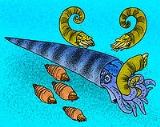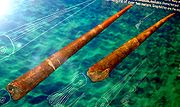
Endoceras
Encyclopedia
Endocerida is an extinct nautiloid order, a group of cephalopod
s from the Lower Paleozoic with cone-like deposits in its siphuncle
.
Endocerida comprises a diverse group of cephalopod
s that lived from the Early Ordovician
possibly to the Late Silurian
. Their shells varied in form. Some were straight (orthoconic) others curved (cyrtoconic); some were long (longiconic), others short (breviconic). Some long-shelled forms like Endoceras
attained lengths as much as 3.5 metres (11.5 ft). The related Cameroceras is anecdotally reported to have reached lengths approaching 9 metres (29.5 ft), but these claims are not unproblematic (Teichert and Kümmel 1960). The overwhelming majority of endocerids and nautiloids in general are much smaller, usually less than a meter long fully grown.
 Endocerids may have had a relatively small body chamber as well as a proportionally large siphuncle
Endocerids may have had a relatively small body chamber as well as a proportionally large siphuncle
that in some reached nearly half the shell diameter, suggesting much of the visceral mass may have been housed within the siphuncle itself rather than just in the body chamber as with other nautiloids. (Teichert,C.1964) Endocerids are primarily distinguished by the presence of calcareous deposits, known as endocones, formed in the more apical portion of the siphuncle and thought to counterweight the animal’s body. The chambers (camerae) of endocerids are always free of organic deposits, unlike other orders such as the Michelinocerida
and Actinocerida
.
s, molluscs, brachiopod
s and other bottom-dwelling organisms. They were probably not active nekton
ic swimmers, but rather crawled over the floor of epicontinental seas or lay there in ambush. They probably filled a different ecological niche
than that filled by such as sharks and squid today.
. In any case, the endocerid lineage became completely extinct relatively early on in cephalopod history.
, most likely from a genus similar to Pachendoceras. This ellesmerocerid gave rise to Proendoceras, the earliest representative of the Proterocameroceratidae
and hence of the Endocerida. Endocerids evolved from ellesmerocerids by reduction of siphuncle diaphragms and the development of endocones. From that time, in the early middle Lower Ordovician, the Endocerida quickly diversified into different families. Two general evolutionary trends can be recognized. In one lineage, the siphuncle grew more complex, resulting in genera such as Chihlioceras and Allotrioceras
. In the other lineage, over size increased, resulting in such genera as Endoceras and Cameroceras.
Flower (1958) divided the Endocerida into two suborders, the Proterocamerocerina and the Endocerina, which respectively follow the two primary evolutionary trends described above. As defined the Proterocamerocerina includes the Proterocameroceratidae, Manchurocheratidae, and Emmonsoceratidae; the Endocerina, the Piloceratidae
and Endoceratidae.
Cephalopod
A cephalopod is any member of the molluscan class Cephalopoda . These exclusively marine animals are characterized by bilateral body symmetry, a prominent head, and a set of arms or tentacles modified from the primitive molluscan foot...
s from the Lower Paleozoic with cone-like deposits in its siphuncle
Siphuncle
The siphuncle is a strand of tissue passing longitudinally through the shell of a cephalopod mollusk. Only cephalopods with chambered shells have siphuncles, such as the extinct ammonites and belemnites, and the living nautiluses, cuttlefish, and Spirula...
.
Endocerida comprises a diverse group of cephalopod
Cephalopod
A cephalopod is any member of the molluscan class Cephalopoda . These exclusively marine animals are characterized by bilateral body symmetry, a prominent head, and a set of arms or tentacles modified from the primitive molluscan foot...
s that lived from the Early Ordovician
Ordovician
The Ordovician is a geologic period and system, the second of six of the Paleozoic Era, and covers the time between 488.3±1.7 to 443.7±1.5 million years ago . It follows the Cambrian Period and is followed by the Silurian Period...
possibly to the Late Silurian
Silurian
The Silurian is a geologic period and system that extends from the end of the Ordovician Period, about 443.7 ± 1.5 Mya , to the beginning of the Devonian Period, about 416.0 ± 2.8 Mya . As with other geologic periods, the rock beds that define the period's start and end are well identified, but the...
. Their shells varied in form. Some were straight (orthoconic) others curved (cyrtoconic); some were long (longiconic), others short (breviconic). Some long-shelled forms like Endoceras
Endoceras
Endocerida is an extinct nautiloid order, a group of cephalopods from the Lower Paleozoic with cone-like deposits in its siphuncle.Endocerida comprises a diverse group of cephalopods that lived from the Early Ordovician possibly to the Late Silurian . Their shells varied in form...
attained lengths as much as 3.5 metres (11.5 ft). The related Cameroceras is anecdotally reported to have reached lengths approaching 9 metres (29.5 ft), but these claims are not unproblematic (Teichert and Kümmel 1960). The overwhelming majority of endocerids and nautiloids in general are much smaller, usually less than a meter long fully grown.
Morphology

Siphuncle
The siphuncle is a strand of tissue passing longitudinally through the shell of a cephalopod mollusk. Only cephalopods with chambered shells have siphuncles, such as the extinct ammonites and belemnites, and the living nautiluses, cuttlefish, and Spirula...
that in some reached nearly half the shell diameter, suggesting much of the visceral mass may have been housed within the siphuncle itself rather than just in the body chamber as with other nautiloids. (Teichert,C.1964) Endocerids are primarily distinguished by the presence of calcareous deposits, known as endocones, formed in the more apical portion of the siphuncle and thought to counterweight the animal’s body. The chambers (camerae) of endocerids are always free of organic deposits, unlike other orders such as the Michelinocerida
Orthocerida
Orthocerida is an order of extinct nautiloid cephalopods also known as the Michelinocerda that lived from the Early Ordovician possibly to the Late Triassic . A fossil found in the Caucasus suggests they may even have survived until the Early Cretaceous...
and Actinocerida
Actinocerida
The Actinocerida comprise an order of generally straight, medium to large cephalopods that lived during the early and middle Paleozoic, distinguished by a siphuncle composed of expanded segments that extend into the adjacent chambers, in which deposits formed within contain a system of radial...
.
Ecology
Endocerids may have been the superpredators of the Ordovician, probably living close to the sea floor, and preying on trilobiteTrilobite
Trilobites are a well-known fossil group of extinct marine arthropods that form the class Trilobita. The first appearance of trilobites in the fossil record defines the base of the Atdabanian stage of the Early Cambrian period , and they flourished throughout the lower Paleozoic era before...
s, molluscs, brachiopod
Brachiopod
Brachiopods are a phylum of marine animals that have hard "valves" on the upper and lower surfaces, unlike the left and right arrangement in bivalve molluscs. Brachiopod valves are hinged at the rear end, while the front can be opened for feeding or closed for protection...
s and other bottom-dwelling organisms. They were probably not active nekton
Nekton
Nekton refers to the aggregate of actively swimming aquatic organisms in a body of water able to move independently of water currents....
ic swimmers, but rather crawled over the floor of epicontinental seas or lay there in ambush. They probably filled a different ecological niche
Ecological niche
In ecology, a niche is a term describing the relational position of a species or population in its ecosystem to each other; e.g. a dolphin could potentially be in another ecological niche from one that travels in a different pod if the members of these pods utilize significantly different food...
than that filled by such as sharks and squid today.
Diversity
Endocerids were among some half a dozen cephalopod orders that appeared in the Lower Ordovician. They reached their greatest diversity during the Lower to Mid-Ordovician, but were already in decline by the middle of this period with most genera becoming extinct by the end of the Sandbian (late Ordovician), while some rare hangers on lasted into the SilurianSilurian
The Silurian is a geologic period and system that extends from the end of the Ordovician Period, about 443.7 ± 1.5 Mya , to the beginning of the Devonian Period, about 416.0 ± 2.8 Mya . As with other geologic periods, the rock beds that define the period's start and end are well identified, but the...
. In any case, the endocerid lineage became completely extinct relatively early on in cephalopod history.
Evolution
Endocerids evolved from the earlier ellesmeroceridsEllesmerocerida
The Ellesmerocerida is a order of primitive cephalopods belonging to the subclass Nautiloidea with a widespread distribution that lived during the Late Cambrian and Ordovician.-Morphology:...
, most likely from a genus similar to Pachendoceras. This ellesmerocerid gave rise to Proendoceras, the earliest representative of the Proterocameroceratidae
Proterocameroceratidae
The Proterocameroceratidae were the first of the Endocerida. They began early in the Ordovician with Proendoceras or similar genus which had developed endocones, replacing the diaphragms of the ellesmerocerid ancestor....
and hence of the Endocerida. Endocerids evolved from ellesmerocerids by reduction of siphuncle diaphragms and the development of endocones. From that time, in the early middle Lower Ordovician, the Endocerida quickly diversified into different families. Two general evolutionary trends can be recognized. In one lineage, the siphuncle grew more complex, resulting in genera such as Chihlioceras and Allotrioceras
Allotrioceras
Allotrioceras is a tubular fossil from the middle Chazyan of New York state, collected by Rousseau H. Flower and included by him in the Endocerida and placed in a new family, the Allotrioceratidae...
. In the other lineage, over size increased, resulting in such genera as Endoceras and Cameroceras.
Taxonomy and classification
Citing its diversity, Curt Teichert (1964) placed the Endocerida in its own subclass called the Endoceroidea or Endoceratoidea. (Some Russian paleontologists ranked it as a superorder instead). Rousseau Flower rejected this separation on the grounds that endocerids were no more diverse or complex than any other order and considered them simply another order within the Nautiloidea.Flower (1958) divided the Endocerida into two suborders, the Proterocamerocerina and the Endocerina, which respectively follow the two primary evolutionary trends described above. As defined the Proterocamerocerina includes the Proterocameroceratidae, Manchurocheratidae, and Emmonsoceratidae; the Endocerina, the Piloceratidae
Piloceratidae
The Piloceratidae are a compressed, rapidly expanding, cyrtoconic brevicones with holochoanitic ventral siphuncles and simple endocones. Most likely evolved from Clitendoceras, a narrow, slightly endogastric genus intermediate in form between straight shelled Proendoceras and the bulkier...
and Endoceratidae.

